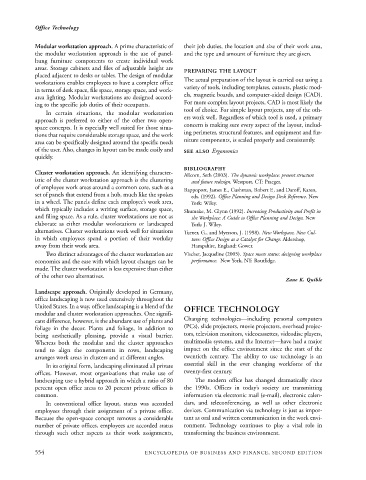Page 577 - Encyclopedia of Business and Finance
P. 577
eobf_O 7/5/06 3:17 PM Page 554
Office Technology
Modular workstation approach. A prime characteristic of their job duties, the location and size of their work area,
the modular workstation approach is the use of panel- and the type and amount of furniture they are given.
hung furniture components to create individual work
areas. Storage cabinets and files of adjustable height are
PREPARING THE LAYOUT
placed adjacent to desks or tables. The design of modular
workstations enables employees to have a complete office The actual preparation of the layout is carried out using a
in terms of desk space, file space, storage space, and work- variety of tools, including templates, cutouts, plastic mod-
area lighting. Modular workstations are designed accord- els, magnetic boards, and computer-aided design (CAD).
ing to the specific job duties of their occupants. For more complex layout projects, CAD is most likely the
tool of choice. For simple layout projects, any of the oth-
In certain situations, the modular workstation
approach is preferred to either of the other two open- ers work well. Regardless of which tool is used, a primary
space concepts. It is especially well suited for those situa- concern is making sure every aspect of the layout, includ-
tions that require considerable storage space, and the work ing perimeter, structural features, and equipment and fur-
area can be specifically designed around the specific needs niture components, is scaled properly and consistently.
of the user. Also, changes in layout can be made easily and SEE ALSO Ergonomics
quickly.
BIBLIOGRAPHY
Cluster workstation approach. An identifying character-
Allcorn, Seth (2003). The dynamic workplace: present structure
istic of the cluster workstation approach is the clustering and future redesign. Westport, CT: Praeger.
of employee work areas around a common core, such as a
Rappoport, James E., Cushman, Robert F., and Daroff, Karen,
set of panels that extend from a hub, much like the spokes eds. (1992). Office Planning and Design Desk Reference. New
in a wheel. The panels define each employee’s work area, York: Wiley.
which typically includes a writing surface, storage space, Shumake, M. Glynn (1992). Increasing Productivity and Profit in
and filing space. As a rule, cluster workstations are not as the Workplace: A Guide to Office Planning and Design. New
elaborate as either modular workstations or landscaped York: J. Wiley.
alternatives. Cluster workstations work well for situations Turner, G., and Myerson, J. (1998). New Workspace, New Cul-
in which employees spend a portion of their workday ture: Office Design as a Catalyst for Change. Aldershop,
away from their work area. Hampshire, England: Gower.
Two distinct advantages of the cluster workstation are Vischer, Jacqueline (2005). Space meets status: designing workplace
economics and the ease with which layout changes can be performance. New York, NY: Routlidge.
made. The cluster workstation is less expensive than either
of the other two alternatives.
Zane K. Quible
Landscape approach. Originally developed in Germany,
office landscaping is now used extensively throughout the
United States. In a way, office landscaping is a blend of the OFFICE TECHNOLOGY
modular and cluster workstation approaches. One signifi-
cant difference, however, is the abundant use of plants and Changing technologies—including personal computers
foliage in the decor. Plants and foliage, in addition to (PCs), slide projectors, movie projectors, overhead projec-
being aesthetically pleasing, provide a visual barrier. tors, television monitors, videocassettes, videodisc players,
Whereas both the modular and the cluster approaches multimedia systems, and the Internet—have had a major
tend to align the components in rows, landscaping impact on the office environment since the start of the
arranges work areas in clusters and at different angles. twentieth century. The ability to use technology is an
essential skill in the ever changing workforce of the
In its original form, landscaping eliminated all private
offices. However, most organizations that make use of twenty-first century.
landscaping use a hybrid approach in which a ratio of 80 The modern office has changed dramatically since
percent open office areas to 20 percent private offices is the 1990s. Offices in today’s society are transmitting
common. information via electronic mail (e-mail), electronic calen-
In conventional office layout, status was accorded dars, and teleconferencing, as well as other electronic
employees through their assignment of a private office. devices. Communication via technology is just as impor-
Because the open-space concept removes a considerable tant as oral and written communication in the work envi-
number of private offices, employees are accorded status ronment. Technology continues to play a vital role in
through such other aspects as their work assignments, transforming the business environment.
554 ENCYCLOPEDIA OF BUSINESS AND FINANCE, SECOND EDITION

